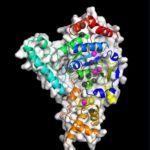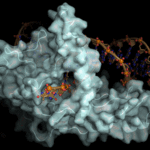Papain-like protease (PLpro) from SARS-CoV-2 plays essential roles in the replication cycle of the virus that is the cause of the global COVID-19 pandemic. In human cells that the virus has infected, PLpro seeks out and binds with the interferon-stimulated gene 15 (ISG15) protein, a key component of the cells’ immune response. PLpro strips ISG15 from other cellular proteins to aid SARS-CoV-2 in evading the body’s immune system.
Scientists at Oak Ridge National Laboratory (ORNL) used small-angle neutron scattering (SANS) at the High Flux Isotope Reactor (HFIR) combined with computational techniques to reveal the molecular details of how the two proteins interact. Susan Tsutakawa, a staff scientist in the Molecular Biophysics and Integrated Bioimaging (MBIB) Division, obtained small-angle x-ray scattering (SAXS) data on the PLpro-ISG15 complex at Berkeley Lab’s Advanced Light Source (ALS) to augment the SANS work.








